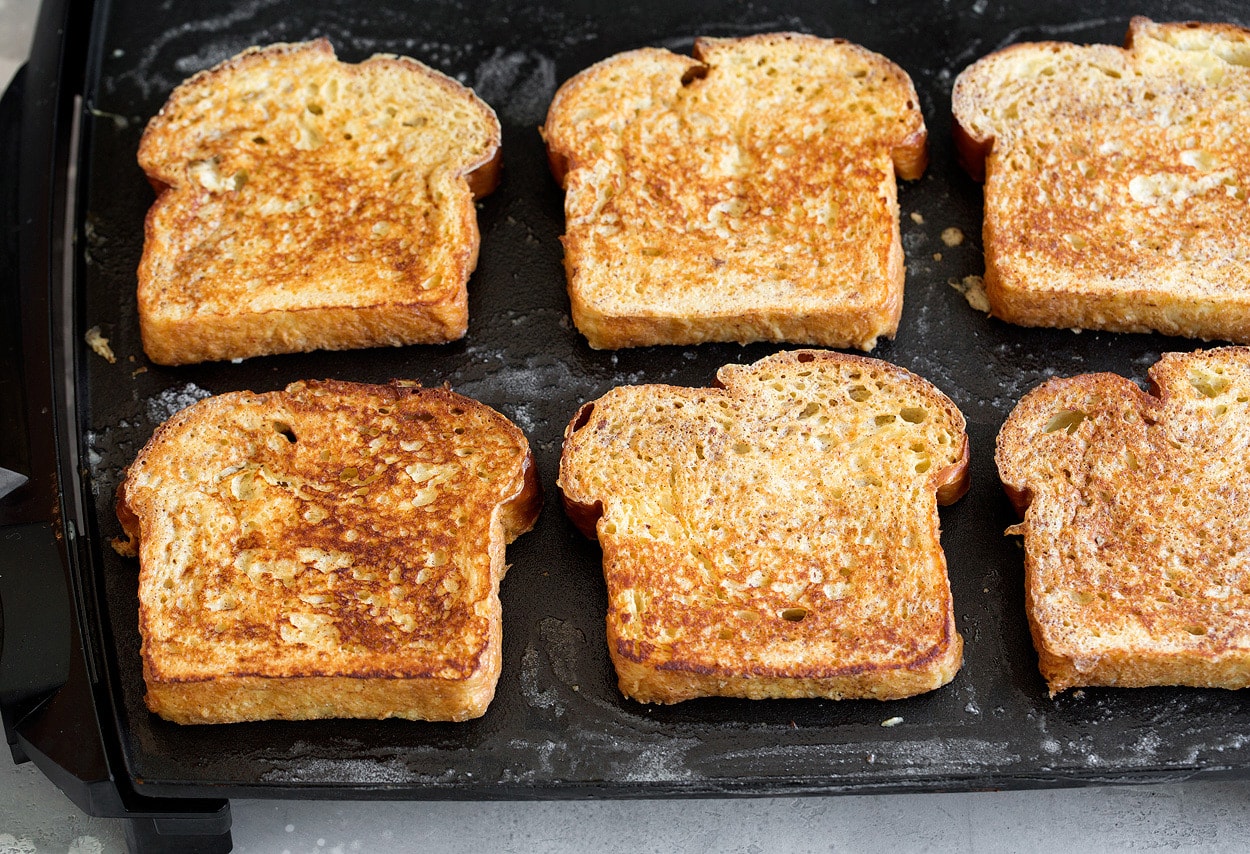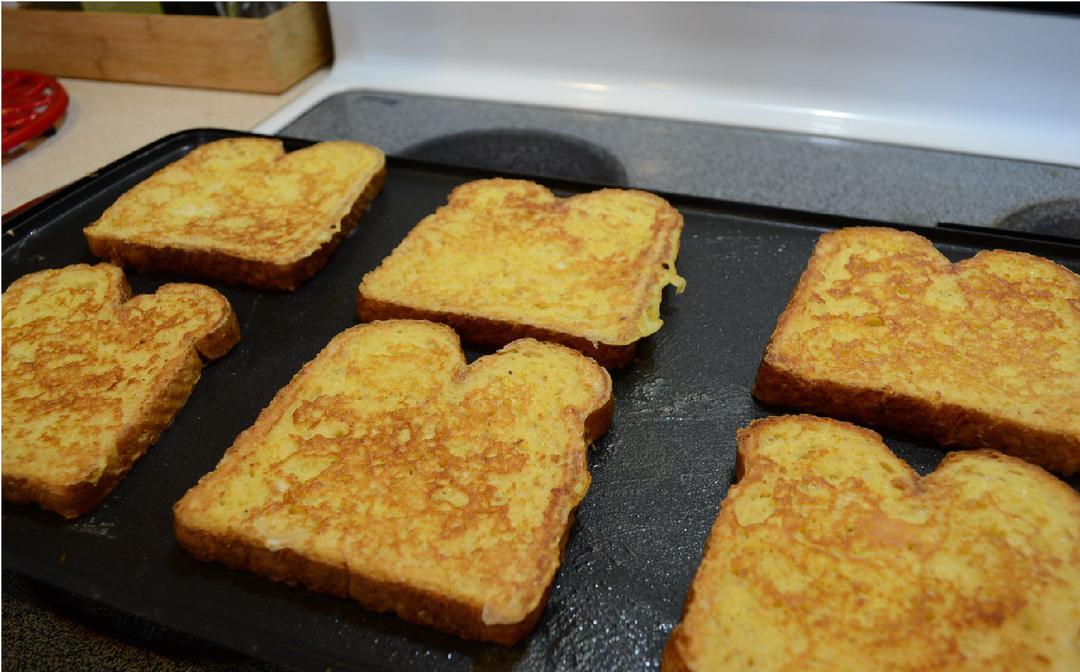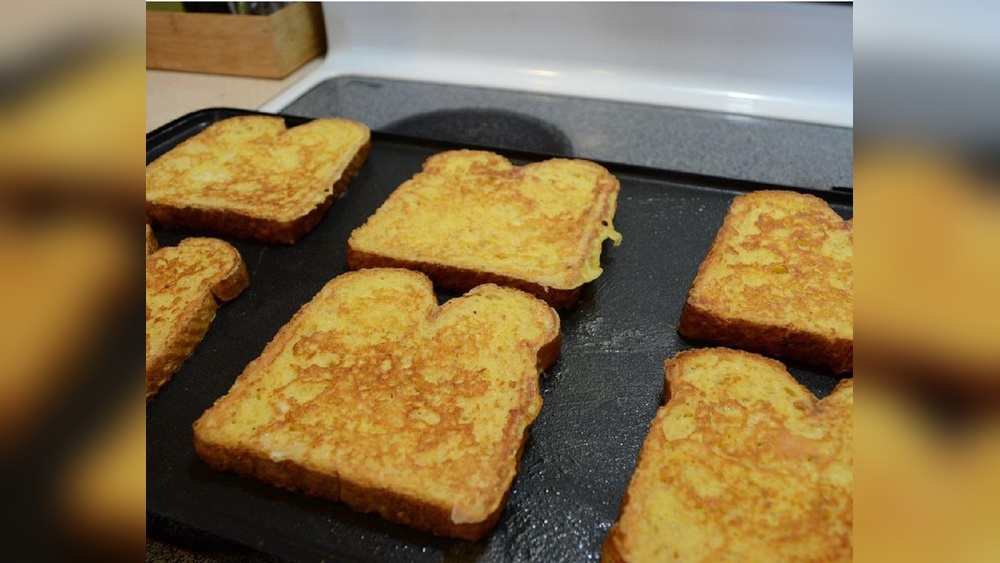You want your French toast to be perfectly golden, crispy on the outside, and soft and custardy on the inside. But getting that just right depends a lot on the temperature you use on your griddle.
Cook it too hot, and the outside burns before the middle cooks through. Too low, and your toast ends up dry and tough, missing that inviting golden crust. So, what temperature should you set your griddle to achieve French toast perfection every time?
Keep reading, and you’ll discover the ideal heat settings and simple tips that will turn your breakfast into a delicious success you’ll want to make again and again.

Credit: recipesfromfrenchcreek.com
Ideal Heat Range
Finding the ideal heat range for cooking French toast on a griddle is key to perfect results. The right temperature cooks the bread evenly without burning or drying it out. It also helps create a golden-brown crust while keeping the inside soft and custardy.
Generally, medium-low heat works best. It offers a good balance between cooking speed and evenness. Adjusting the heat as the griddle warms up can improve the texture and flavor of your French toast.
Medium-low Benefits
Cooking French toast at medium-low heat allows gentle cooking. The egg mixture seeps into the bread and cooks slowly. This heat prevents burning while creating a rich, creamy inside. The outside turns golden brown without getting too dark. Medium-low heat keeps the toast tender and moist.
Avoiding High Heat
High heat cooks the outside too fast. The crust burns before the inside cooks through. This results in a burnt surface and raw, soggy center. High heat can ruin the texture and taste of French toast. It is best avoided for a perfectly cooked dish.
Drawbacks Of Low Heat
Cooking on very low heat may take too long. The bread can dry out and become tough. Low heat often fails to brown the toast properly. This leaves the French toast pale and less appetizing. Avoid using too low heat to keep texture and color balanced.
Adjusting Temperature
Adjusting the temperature on your griddle is key to cooking perfect French toast. It controls how evenly the bread cooks and how well the flavors develop. Getting this right means your toast will have a crispy outside and a soft, cooked inside. Watch the heat closely as you cook. Changes in temperature affect the cooking speed and texture of the toast.
Starting At Medium Heat
Begin cooking French toast at medium heat. This temperature heats the griddle evenly. It allows the bread to absorb the egg mixture well. Medium heat helps create a golden crust quickly. The inside starts cooking without drying out. This setting works well for thick slices.
Lowering Heat To Prevent Burning
After the toast browns, reduce the heat to medium-low. Lower heat stops burning the outside. It gives the inside time to cook fully. Medium-low heat keeps the toast warm and soft inside. It also helps maintain the golden color. Adjust the heat as needed throughout cooking.
Signs To Reduce Heat
Look for fast browning or smoke as signals to lower heat. If the toast darkens too quickly, lower the temperature. Burning edges or a burnt smell also call for less heat. The toast should cook evenly with no burnt spots. Adjust heat before the toast finishes cooking for best results.
Cooking Techniques
Cooking French toast on a griddle needs care and the right techniques. The temperature matters, but so does how you cook it. Using the right fat, managing batches, and keeping the toast crispy all affect the final taste and texture. These tips help you make perfect French toast every time.
Using Butter Vs Oil
Butter adds rich flavor and helps brown the toast evenly. It melts quickly, so watch the heat to avoid burning. Oil lasts longer on the griddle and can handle higher heat without smoking. Choose vegetable or canola oil for a neutral taste. Mixing butter and oil can give good flavor and prevent burning.
Batch Cooking Tips
Cook French toast in small batches to keep the griddle temperature steady. Crowding the pan lowers heat and makes the toast soggy. After cooking a batch, keep toast warm on a baking sheet in a low oven. This keeps it hot and crispy while you finish the rest.
Maintaining Crispiness
Use medium-low heat to get a golden crust without burning. Flip the toast gently to keep the coating intact. Let the toast rest on a wire rack after cooking to avoid moisture buildup. Avoid stacking pieces, which traps steam and makes the toast soft.
Griddle Temperature Guide
Cooking French toast on a griddle requires the right temperature for perfect results. The griddle temperature affects how the bread cooks inside and how the outside browns. This guide explains the best temperature to use, how to watch the surface heat, and the tools that help control the heat for delicious French toast every time.
Recommended Griddle Temp
Set the griddle between 325°F and 375°F for French toast. This range cooks the bread through without burning the outside. Medium-low heat helps the egg soak in and cook gently. Avoid high heat because it burns the toast quickly. Low heat makes the bread dry and tough without a nice crust. Start at medium heat, then lower if it browns too fast.
Monitoring Surface Heat
Watch the griddle surface carefully. If the toast turns dark brown in less than two minutes, the heat is too high. If it stays pale after several minutes, the temperature is too low. Adjust heat in small steps. Use a spatula to lift the bread and check the color. Flip when the bottom is golden brown for even cooking.
Temperature Tools
Use a griddle thermometer to measure surface heat accurately. This tool helps keep the temperature steady. Infrared thermometers are great for quick surface checks. Some electric griddles have built-in temperature controls. These controls keep the heat consistent for better cooking results. Using the right tools prevents guesswork and ensures perfect French toast every time.
Bread Selection Tips
Selecting the right bread is key for perfect French toast on a griddle. The bread affects taste, texture, and how well it absorbs the custard mix. Choosing the best bread helps achieve a golden crust and soft inside. Knowing the ideal thickness and soaking method keeps the toast from becoming soggy. Follow these bread selection tips for a delicious breakfast treat.
Best Bread Types
Thick, sturdy breads work best for French toast. Brioche, challah, and Texas toast are popular choices. These breads absorb the egg mixture well without falling apart. Avoid very soft or thin breads like sandwich bread. They soak too much and become mushy. Fresh or slightly stale bread both work fine, but slightly stale bread holds up better.
Thickness And Soaking
Cut bread slices about 3/4 to 1 inch thick. Thick slices soak the custard mix without breaking. Soak each slice for 20 to 30 seconds on each side. This allows the bread to absorb enough liquid for a soft inside. Do not soak too long or the bread will become soggy and hard to cook. Proper soaking ensures even cooking and good texture.
Avoiding Sogginess
Use bread that is slightly dry or toasted before soaking. This prevents it from absorbing too much liquid. Drain excess custard from the bread before placing it on the griddle. Cook French toast on medium-low heat to avoid soggy centers. Flip gently to keep the toast intact. Proper bread choice and preparation stop sogginess and create a crispy outside.

Credit: www.cookingclassy.com
Alternative Cooking Methods
French toast cooks well on a griddle, but there are other ways to prepare it. Alternative cooking methods can save time or give a different texture. Each method has its own benefits and tips for perfect results. Explore these options to find what suits your kitchen and taste best.
Oven-baked French Toast
Oven-baked French toast is easy and great for serving many people. Preheat the oven to 350°F (175°C). Arrange soaked bread slices in a single layer on a greased baking dish. Bake for 20 to 25 minutes until golden and set. Flip halfway through for even browning. This method cooks evenly without flipping each piece. It keeps the toast soft inside and slightly crisp outside.
Stovetop Skillet Tips
Using a skillet on the stovetop is a classic way to cook French toast. Heat the pan over medium-low heat. Add butter or oil to prevent sticking. Place soaked bread slices in the skillet carefully. Cook for 3 to 4 minutes per side. Look for a golden brown color before flipping. Avoid high heat; it burns the outside and leaves the inside raw. Adjust the temperature as needed to cook through without burning.

Credit: www.sidechef.com
Frequently Asked Questions
Is It Better To Cook French Toast On Low Or High Heat?
Cook French toast on medium-low to medium heat for a golden crust and fully cooked center. Avoid high heat to prevent burning. Low heat may dry it out. Adjust heat as needed to brown evenly without burning or undercooking the inside.
What Temperature Do You Cook French Toast?
Cook French toast on medium-low to medium heat. This ensures a golden-brown crust and a fully cooked, custardy inside without burning. Avoid high heat to prevent burning outside and raw inside. Lower heat may dry out the bread without proper browning.
What Temperature To Toast Bread On A Griddle?
Toast bread on a griddle at medium-low to medium heat, around 300°F to 350°F. This ensures even browning without burning.
What Is The Best Temperature To Cook On A Griddle?
Cook on medium-low to medium heat, around 300°F to 350°F, for even cooking without burning the outside.
Conclusion
Cooking French toast on a griddle works best at medium-low to medium heat. This temperature cooks the inside gently while giving the outside a golden crust. Too high heat burns the toast before it cooks through. Too low heat makes it dry and pale.
Start at medium heat, then lower if browning happens too fast. Patience pays off with soft, creamy French toast every time. Enjoy your perfect breakfast!

